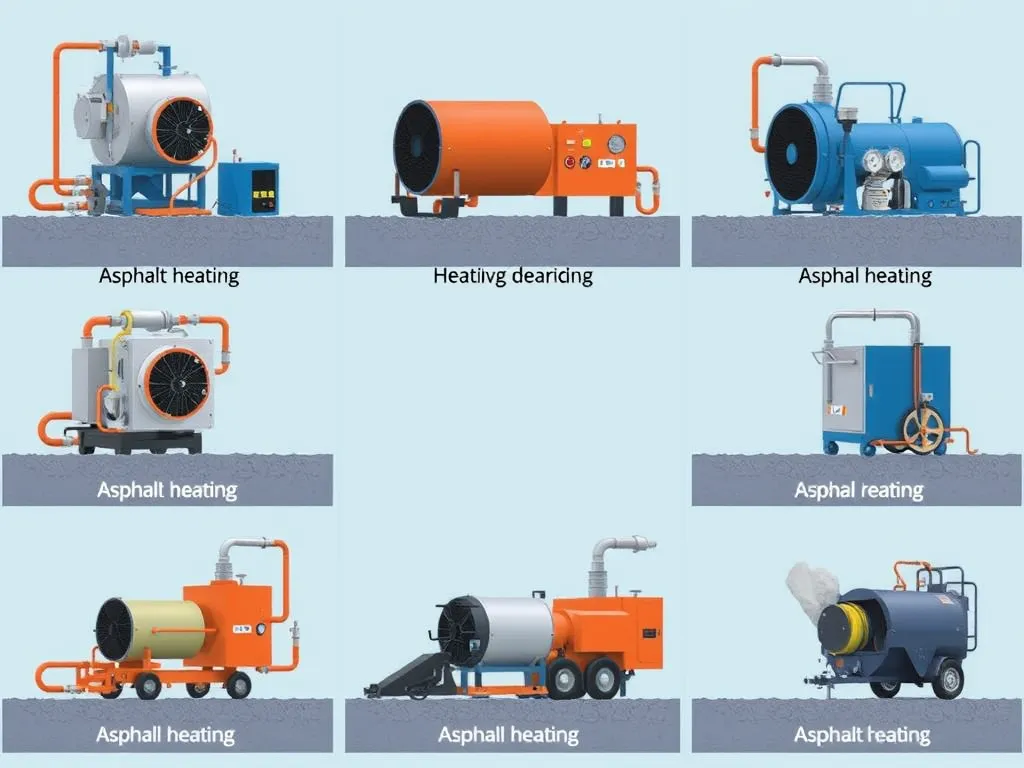How Bitumen Bonds: The Science Behind Durable Roads
Published on: September 12, 2025 | Last Updated: April 14, 2025
Written By: George Voss
Bitumen adhesion mechanisms are the physical and chemical processes that bind asphalt binder to aggregate surfaces. These interactions determine pavement strength, prevent water damage, and resist cracking. Key forces include Van der Waals attractions (weak molecular bonds), mechanical interlocking between bitumen and rough aggregate textures, hydrogen bonding, and surface energy compatibility. Factors like aggregate mineralogy, binder viscosity, temperature changes, and moisture levels directly impact bond quality.
This article explains how bitumen sticks to rocks in asphalt mixes and why it sometimes fails. We’ll cover the science behind adhesion forces, lab testing methods like pull-off tests (AASHTO T 59), and real-world factors from aggregate porosity to winter freeze-thaw cycles. You’ll learn practical strategies to enhance adhesion in pavement designs and extend road lifespans beyond 20 years.
Contents
- What is Bitumen Adhesion?
- Importance Of Bitumen Adhesion in Asphalt Pavements
- Key Mechanisms Of Bitumen Adhesion
- Factors Affecting Bitumen Adhesion
- Mechanisms Of Bitumen Stripping in Asphalt
- Evaluating Bitumen Adhesion in Asphalt
- Environmental Impact on Bitumen Adhesion
- FAQ: Bitumen Adhesion Mechanisms
- Closing Thoughts
- Useful References for You:
What is Bitumen Adhesion?
Bitumen adhesion forms the backbone of durable asphalt surfaces. This process determines how effectively bitumen sticks to aggregates like crushed stone or sand. Without strong adhesion, pavements lose structural integrity within months.
Definition Of Bitumen Adhesion
Bitumen adhesion refers to the chemical and physical forces binding bitumen to aggregate surfaces. These interactions include van der Waals forces (weak molecular attractions), mechanical interlocking (bitumen filling aggregate pores), and hydrogen bonding. The American Society for Testing and Materials (ASTM D3625) defines adhesion as the bitumen’s ability to resist stripping from aggregates under stress.
Role Of Adhesive Forces in Asphalt Performance
Adhesive forces directly dictate pavement lifespan. Strong bitumen bonding mechanisms:
- Distribute traffic loads evenly, reducing rutting by 30-50%
- Block water infiltration – a key cause of potholes
- Maintain flexibility between -20°F and 140°F
Weak adhesion triggers raveling, stripping, and premature cracks. For example, pavements with adhesion failure often show 40-60% higher maintenance costs within five years.
Mastering these bonding principles paves the way for exploring advanced adhesion testing methods. Next, we’ll break down how adhesion strength gets measured in labs and field settings.
Importance Of Bitumen Adhesion in Asphalt Pavements
Strong bonds between bitumen and aggregates form the backbone of durable road surfaces. These bonds dictate how asphalt withstands traffic loads, weather extremes, and time.
Impact on Pavement Durability
Bitumen adhesion directly determines pavement lifespan. Proper bonding allows asphalt layers to act as a unified structure, resisting shear forces from vehicles exceeding 40,000 lbs per axle. Roads with optimal adhesion last 10-15 years before major repairs. Weak bonds accelerate structural breakdown, leading to rut depths over 0.5 inches within 3-5 years.
| Adhesion Quality | Pavement Lifespan | Common Failures |
|---|---|---|
| Strong | 12+ years | Surface oxidation only |
| Weak | 5-8 years | Potholes, base erosion |
Preventing Raveling and Cracking
Bitumen adhesive forces combat two critical failure modes. Raveling occurs when loose aggregates detach due to poor bonding, creating surface gaps wider than 1/8 inch. Cracking starts when thermal stresses (-30°F to 150°F) overpower bitumen’s cohesive strength. Superior adhesion redistributes these stresses across the pavement matrix, reducing crack propagation rates by 60-75%.
Advanced mixes now use polymer-modified binders with adhesion promoters like hydrated lime (1-2% by weight). These boost bond strength by 30-50% on granite aggregates, measured through pull-off tests exceeding 250 psi.
Next, we’ll examine the molecular forces and physical processes that create these vital bonds.

Key Mechanisms Of Bitumen Adhesion
Bitumen bonds to aggregates through five key processes. These forces shape how asphalt lasts under traffic, heat, and water.
Van Der Waals Forces
Weak molecular pulls form between bitumen and stone. These forces (0.1-4 kJ/mol) work best when aggregates are dry and clean. Warm bitumen flows into tiny pores, boosting contact for stronger Van der Waals bonds.
Mechanical Interlocking
Bitumen grips rough stone surfaces like Velcro. Angular crushed rock holds 40% better than smooth gravel. This locking resists shear forces from truck tires moving at 70 mph.
Hydrogen Bonding
Polar groups in bitumen (-OH, -NH) stick to water films on rocks. But too much water breaks bonds. Tests show 2% moisture cuts adhesion by half in limestone mixes.
Surface Energy Interactions
High-energy stones (like granite) bond tight with bitumen. The contact angle method measures this: angles under 90° mean good wetting. Lime-treated aggregates boost surface energy by 15-20 mN/m.
Thermodynamic Theory
Adhesion follows energy rules: W = γbitumen + γaggregate – γinterface. Lower γinterface means better bonds. Polymer modifiers can cut interface energy by 30%, making roads last 5-7 years longer.
While these mechanisms form the glue of asphalt, their success depends on material choices and site conditions. Next, we explore how rock types, weather, and mix designs shape real-world adhesion.
Also See: Best Practices for Excavation Techniques for Asphalt Driveway
Factors Affecting Bitumen Adhesion
Bitumen adhesion mechanisms depend on material traits and external elements. Three primary factors shape bond strength between asphalt binder and aggregates.
Aggregate Properties
Aggregate mineralogy directly affects bitumen adhesion properties. Surface texture and absorption rates determine how well binders grip stone particles.
Mineralogy and Porosity
Limestone forms stronger bonds than granite due to higher calcium carbonate content. Porous aggregates like sandstone absorb up to 2.5% bitumen by weight, reducing surface adhesion. Optimal porosity ranges between 1.8-2.2% for balanced absorption and grip.
Surface Roughness
Rough-textured aggregates boost mechanical interlocking. Angular crushed stone with 0.4-0.6 mm surface irregularities improves adhesion by 30% compared to smooth river gravel.
Bitumen Characteristics
Bitumen bonding processes rely on chemical makeup and physical behavior. Viscosity and aging alter adhesive performance over time.
Chemical Composition
Asphaltenes (15-25% content) enhance bitumen stickiness through polar molecule attraction. Low-molecular-weight maltenes improve wettability but reduce cohesion. PG 64-22 binders show 40% better adhesion than PG 58-28 grades in freeze-thaw tests.
Viscosity and Aging
High-viscosity bitumen (3,000 Poise at 60°C) resists aggregate coating. Oxidative aging raises viscosity by 65% after 5 years, weakening adhesive bonds. Polymer-modified binders slow aging rates by 18-22%.
Environmental Conditions
External factors like weather and moisture reshape adhesion mechanism bitumen dynamics during installation and service life.
Temperature Fluctuations
Bitumen loses 50% adhesion strength when temps drop from 20°C to -10°C. Thermal cycling causes 0.3 mm/year bond degradation in northern climates.
Moisture Content
1% water infiltration can strip 70% of bitumen-aggregate bonds within 6 months. Hydrophilic aggregates (like granite) show stripping at 80% RH levels.
Humidity Levels
Mixing at 85% RH reduces initial adhesion by 15%. Condensation forms 5-10 μm water films that block bitumen bonding mechanisms during pavement layering.
These variables set the stage for adhesion failures. Next, we explore how stripping occurs when bonds break under stress.

Mechanisms Of Bitumen Stripping in Asphalt
Bitumen stripping occurs when bonding between bitumen binder (bitumen bonding mechanism) breaks down, leading to pavement degradation. Three primary factors drive this failure: physical separation, chemical reactions, (mechanisms of bitumen adhesion) and environmental stress.
Causes Of Adhesion Failure
Stripping initiates when forces disrupting (adhesion of bitumen to aggregates) overpower bonding strength. Common triggers include:
- Pollutants or dust layers on stone surfaces blocking proper bonding
- Bitumen oxidation reducing its (bitumen stickiness mechanism) by 40-60% over 5-7 years
- Chemical mismatches between acidic bitumen (bitumen adhesive mechanism) and basic limestone aggregates
Thermal cycling worsens these issues, creating microcracks where moisture penetrates.
Role Of Water Infiltration
Water acts as both solvent (adhesion and cohesion mechanisms of bitumen) and mechanical disruptor. At 20°C, just 0.1% moisture content can lower bonding strength by 35% through:
| Process | Effect |
|---|---|
| Hydrolysis | Breaks chemical bonds at bitumen-stone interface |
| Capillary action | Lifts bitumen film from stone pores |
| Freeze-thaw | Expands ice volume by 9%, fracturing bonds |
Hydrogel Sliding Friction Theory
This theory explains how trapped water forms hydrogel layers (layer adhesion mechanisms) between bitumen and stone. Under traffic loads exceeding 80 kN, these lubricating films enable:
- 40-70% reduction in interfacial friction
- Progressive bitumen film displacement at rates up to 3 mm/year
Polymer-modified binders combat this by increasing hydrogel viscosity (mechanistic adhesion bitumen system), slowing stripping progression.
Evaluating these failure modes requires precise testing methods to quantify remaining bonding capacity.
Evaluating Bitumen Adhesion in Asphalt
Assessing bitumen bonding quality is vital for long-lasting roads. Both lab trials and on-site checks verify how well bitumen sticks to aggregates, spotting weak bonds before pavements fail.
Laboratory Testing Methods
Lab tools mimic real-world stress on asphalt mixes. These trials quantify bitumen adhesion properties under controlled conditions, aiding mix design optimization.
Pull-Off Tests (AASHTO T 59)
This method pulls bitumen-coated aggregates apart using a hydraulic jack. Forces from 100-800 psi indicate bond strength. Low values signal poor bitumen adhesion mechanisms, often due to dirty aggregates or wrong binder grades.
Dynamic Mechanical Analysis (DMA)
DMA applies oscillating stress to bitumen films at -20°C to 60°C. It tracks stiffness changes, showing how temperature shifts affect the bitumen bonding process. Phase angles above 45° hint at weak adhesion under traffic loads.
Contact Angle Measurements
A goniometer measures how bitumen droplets spread on aggregate surfaces. Angles below 90° suggest strong adhesion of bitumen to aggregates. Silica-rich rocks like granite often show angles 15° lower than limestone, boosting bond durability.
Field Evaluation Techniques
On-site checks find adhesion flaws in active roads. These methods link lab data to real-world performance, guiding repair choices.
Visual Inspection for Stripping
Inspectors hunt for wet spots or gray patches—signs of bitumen stripping. Probe tests on loose aggregates assess if binder clings to rocks. Over 5% bare spots in a 10 sq.ft zone call for urgent fixes.
Raveling Assessment
Raveling—loose stones on pavement surfaces—points to failed bitumen adhesive forces. Sand patch trials quantify lost material: more than 0.2 lb/sq.yd within a year signals poor bonding mechanisms bitumen teams must address.
While lab and field tests spot adhesion issues, external factors also sway long-term pavement performance. Up next: how weather shifts challenge bitumen’s grip on aggregates.

Environmental Impact on Bitumen Adhesion
External factors shape how well bitumen bonds with aggregates over time. Weather patterns, moisture levels, and thermal shifts directly affect pavement longevity by altering adhesion dynamics.
Moisture-induced Damage
Water infiltration triggers 70% of adhesion failures in asphalt. Hydrostatic pressure forces moisture between bitumen and aggregates, weakening van der Waals forces and hydrogen bonds. Freeze-thaw cycles worsen this by expanding trapped water, creating microcracks that accelerate debonding. Coastal roads face added risks from saltwater, which reduces bitumen stickiness by 15-20% compared to freshwater exposure.
Temperature-dependent Performance
Bitumen’s viscoelastic nature means adhesion strength swings with mercury-like fluidity. At 140°F, modulus values drop below 1 GPa, allowing aggregate slippage. Below -20°F, thermal contraction creates tensile stresses exceeding 300 psi, fracturing bonds. Daily temperature swings of 50°F can degrade adhesion properties by 40% within five years through repeated expansion-contraction cycles.
Mitigation Strategies
Modern solutions blend chemistry with engineering:
- Anti-stripping additives (0.5-2% hydrated lime or amine-based agents) boost moisture resistance by 60%
- Polymer-modified bitumen (SBS, EVA) maintains adhesion across -40°F to 176°F temperature ranges
- Aggregate pre-treatment with Portland cement slurry reduces water absorption by 35%
- Open-graded friction courses improve drainage, cutting moisture contact time by 80%
These approaches work best when paired with proper compaction (92-96% density) and slope gradients exceeding 2% for runoff. Field data shows they extend pavement service life by 7-12 years in wet climates.
Testing proves which strategies work – but how do engineers measure real-world adhesion performance?
FAQ: Bitumen Adhesion Mechanisms
What Causes Bitumen Stripping in Asphalt?
Bitumen stripping occurs due to the weakening of the bonds between the bitumen and aggregate surfaces. This can be caused by various factors including environmental conditions, such as moisture infiltration and temperature fluctuations, or by pollutants and contaminants that prevent proper adhesion. When moisture gets trapped between the bitumen and the aggregate, it can lead to hydrolysis and mechanical disruption, resulting in stripping.
How is Bitumen Adhesion Measured in the Lab?
Bitumen adhesion is typically measured through a variety of laboratory tests designed to simulate real-world conditions. Common methods include Pull-Off Tests (AASHTO T 59), where a hydraulic jack measures the force required to separate bitumen-coated aggregates; Dynamic Mechanical Analysis (DMA), which applies oscillating stress to evaluate how bitumen stiffness changes with temperature; and Contact Angle Measurements, which assess how well bitumen spreads on aggregate surfaces. Lower contact angles correspond to better adhesion.
Closing Thoughts
Understanding bitumen adhesion mechanisms is vital for the design and longevity of asphalt pavements. The interplay of forces like Van der Waals attraction, mechanical interlocking, and hydrogen bonding ensures a strong bond between bitumen and aggregates. Factors such as aggregate properties, bitumen characteristics, and environmental conditions significantly influence this adhesion.
Monitoring these factors can prevent issues like raveling and cracking, thus enhancing pavement durability. Regular testing methodologies, both in the lab and in the field, can identify adhesion strengths and weaknesses, promoting early corrective actions.
For more insights and tools related to asphalt calculations and pavement performance, check out Asphalt Calculator USA.
Useful References for You:
- Lavin, P. (2003). Asphalt Pavements: A Practical Guide to Design, Production, and Maintenance for Engineers and Architects. London: Taylor & Francis.
- Polymers | Free Full-Text | Increasing the Adhesion of Bitumen to the Surface of Mineral Fillers through Modification with a Recycled Polymer and Surfactant Obtained from Oil Refining Waste
- Adhesion in Bitumen/Aggregate System | Encyclopedia MDPI
- (PDF) Adhesion in Bitumen/Aggregate System: Adhesion Mechanism and Test Methods
- Adhesion in Bitumen/Aggregate System: Adhesion Mechanism and Test Methods


